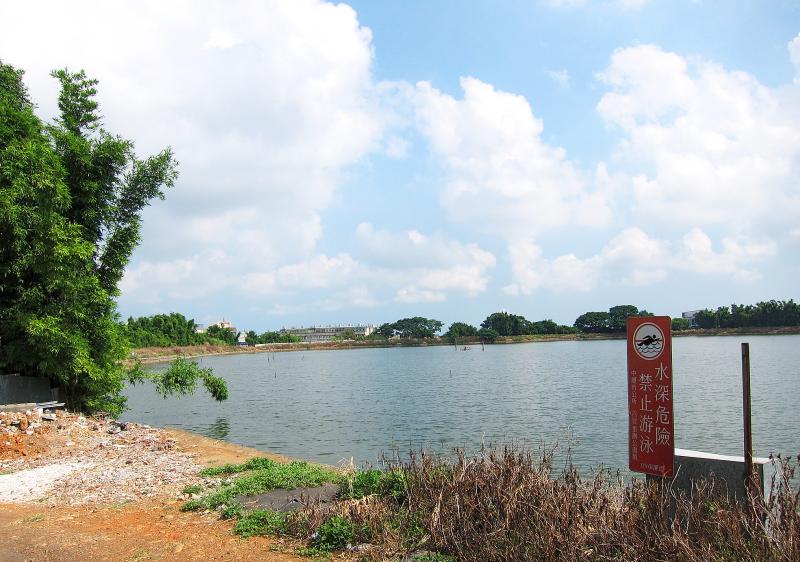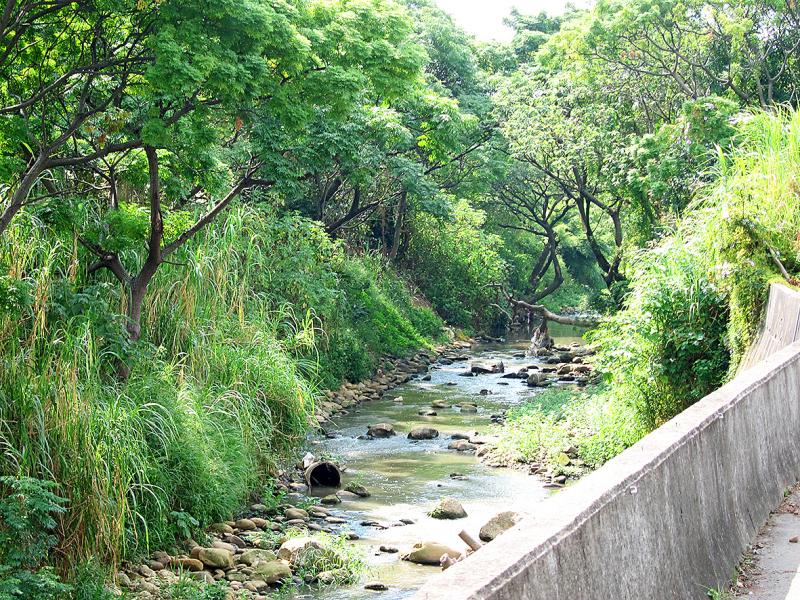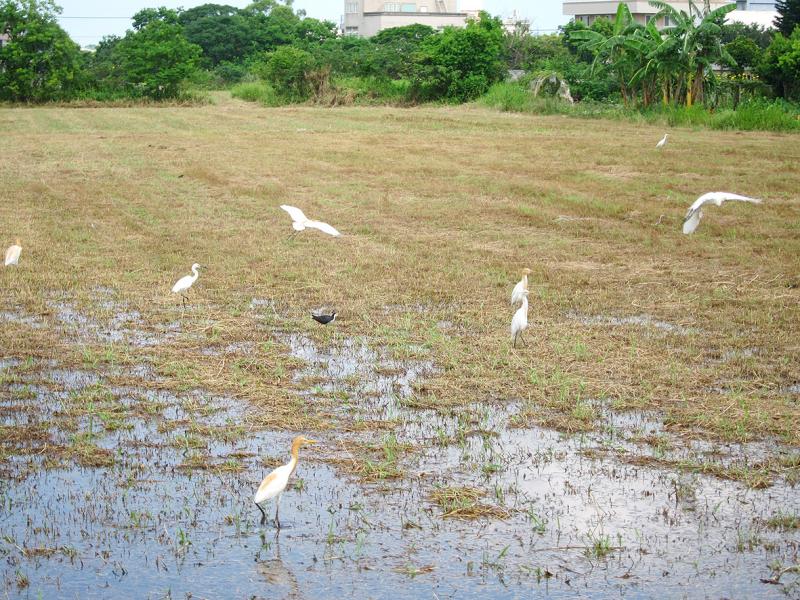In the Biblical account, Noah puts two of every animal on the Ark, but plants are left to fend for themselves or drown in the Flood, unmentioned. The old idea of the Great Chain of Being, with humans above animals and plants at the bottom, still governs the way we think and present information about the world and its creatures. Most educated people know about Darwin, evolution and his work with finches, but few ever think of Darwin as a botanist, much less as the author of a classic, hugely influential work on insectivorous plants. Likewise, today humans in Taiwan deplore the loss of clouded leopards and create parks to protect rare salmon, but aquatic plants remain beneath public notice. Yet just outside Taipei a wealth of rare and interesting water plants underpin rich and diverse ecosystems, created and sustained by human action, now powerfully threatened and slowly vanishing: the ponds of Taoyuan.
It is sobering to recall that Taoyuan, a high, dry plateau stuffed with rice paddies and factories, both of which rely on a copious supply of water, is nearly bereft of natural waterway access. In former times no stable river crossed the plateau. The agricultural success of the plateau is due entirely to human creation of water systems, including the thousands of ponds that gave the region its nickname as “county of a thousand ponds,” where locals describe the climate as having “two droughts every three years.”
“Digging ponds to hold water is not rare in an agricultural society that grows water paddies, but ponds dug in such quantity, size and density are nowhere else to be found in the world,” notes one research survey on them.

Photo: Michael Turton
Pond creation began with waterhole creation by the local aboriginal peoples, who transferred their technologies to the settlers from China. The red clay soils of the area resisted water absorption, making it ideal for water storage. The settlers soon learned to form waterproof banks to hold water by mixing the clay with pebbles and compressing the mixture tightly. These waterworks used neither windmills nor pumps to move water between them. Instead, the ponds were cleverly placed so that gravity would do the heavy work.
The pond systems created during the Qing Dynasty after the early 18th century, coupled with the canal systems begun in the first decade of the 20th century by the famed Japanese engineer Yochi Hatta, the first large water conservation system on the island, led to the area being known as the granary of northern Taiwan later in the Japanese period.
In the 1970s a census showed over 8,800 such ponds, but Taiwan’s developmentalist state has relentlessly destroyed them. Taiwan’s laws specify that each pond must have a single identifiable owner, making it easy for land developers to negotiate purchases. Not only have many been converted to private land or recreational fishing ponds, but the government has been particularly guilty in paving them over with parks, schools and public buildings. One government Web site notes that Taoyuan Prison, the Taoyuan City Government office and Chienkuo Junior High School were all built over ponds. Large-scale projects like the Aerotropolis and the MRT are expected to destroy many more. The area’s canal network has also contracted significantly since the 1970s under the relentless pressure of urbanization

Photo: Michael Turton
After the Shihmen Reservoir (石門水庫) came online it provided irrigation water for the area, making the plateau less dependent on the ponds. Though they provide less than half the area’s irrigation water, the local irrigation association mandates that they must be kept 80 percent full as insurance against droughts. A 2011 paper observes that at that time they held water equal to one-fourth the capacity of the Shihmen Reservoir.
USEFUL PONDS
Today less than 3,000 ponds remain, though that figure has been relatively stable in the last two decades. However, local governments, environmental organizations and landowners are pushing back. Indeed, the Ministry of Culture, recognizing their importance for both the local ecology and local culture, especially Hakka culture, has placed them on its list of potential World Heritage sites in Taiwan.

Photo: Michael Turton
One attractive use for the ponds is for floating solar power installations. The first solar photovoltaic (PV) system in a pond in Taoyuan was a demonstration system built near Beihu Elementary School in northwestern Taoyuan city. The system is still clearly visible in satellite photos. According to the Taoyuan city government EPA, such pond systems inhibit the growth of algae and consequent eutrophication and reduce evaporation. At the same time, the water cools the system, increasing its output over comparable land and rooftop systems. The demonstration system at Beihu Township (北湖) provides enough power to run 170 households. The system also has no effect on the pond’s irrigation, flood control and storage functions. Recognizing the ponds’ potential as PV sites, scholars have already begun studying how the systems can be constructed to harmonize them with local environmental and social needs.
Scientists and locals have long recognized that the ponds provide services to other species besides Homo sapiens. Because of their wealth of interesting aquatic plants including Frogsmouth, Pingpeng grass and wild water chestnuts, especially insectivorous plants like Sundews, they attract insects, amphibians and reptiles, who bring in migratory wetland and dryland birds. Numerous bird species overwinter in northern Taiwan, now an important site for migrating birds thanks to the pond system. Snakes such as kraits and ring snakes are denizens of local ponds, as are ospreys and owls. Beautiful birds such as Pheasant-tailed Jacanas used to be common, but development has chased off many of them. Development has also threatened rare species such as the Taipei Grass Frog.
The tourist potential of the ponds may be an important factor in their preservation as Taiwan’s tourism and leisure economy grows. Older examples such as Longtan Lake (龍潭湖) with its splendid Nantian Palace or the complex of Hakka houses, ponds and irrigation systems around Fan Jiang Ancestral Hall (范姜祖堂) in Sinwu District (新屋) have long been staples of local tourism. Because each pond is its own rich ecological universe, many local landowners and local governments have begun to recreate the ponds as eco-tourism sites. For instance, in Bade District (八德) the Bade Pond Ecological Park (八德埤塘自然生態公園) covers five hectares, with trails, pavilions for enjoying the scenery and the inevitable cafes.

Photo: Michael Turton
Such eco-parks are often deplored or dismissed as shallow, showy responses to the human impact on the environment, but research shows that ecological park ponds and undisturbed ponds have higher species richness for insects such as dragonflies and damselflies. Other papers point to seldom-recognized pond functions, such as cooling the local climate.
The government’s proposed creation in 2008 of the Taoyuan Aerotropolis with its plans to swallow local land, destroy ponds and evict local farmers led activists, scholars, scientists and local community organizations to band together. Eventually they got the government to change its plans to preserve the ponds as local cultural heritage. The Aerotropolis was a huge project that attracted great attention — fewer eyes are on the day-to-day destruction of Taoyuan’s ponds, yet that is just as serious. Let’s hope that local governments and communities continue to fight to preserve these local heritage sites with their rich history and biodiversity for generations to come.
Long-time resident Michael Turton provides incisive commentary informed by three decades of living in and writing about Taiwan.

As I finally slid into the warm embrace of the hot, clifftop pool, it was a serene moment of reflection. The sound of the river reflected off the cave walls, the white of our camping lights reflected off the dark, shimmering surface of the water, and I reflected on how fortunate I was to be here. After all, the beautiful walk through narrow canyons that had brought us here had been inaccessible for five years — and will be again soon. The day had started at the Huisun Forest Area (惠蓀林場), at the end of Nantou County Route 80, north and east

Exceptions to the rule are sometimes revealing. For a brief few years, there was an emerging ideological split between the Democratic Progressive Party (DPP) and Chinese Nationalist Party (KMT) that appeared to be pushing the DPP in a direction that would be considered more liberal, and the KMT more conservative. In the previous column, “The KMT-DPP’s bureaucrat-led developmental state” (Dec. 11, page 12), we examined how Taiwan’s democratic system developed, and how both the two main parties largely accepted a similar consensus on how Taiwan should be run domestically and did not split along the left-right lines more familiar in

Specialty sandwiches loaded with the contents of an entire charcuterie board, overflowing with sauces, creams and all manner of creative add-ons, is perhaps one of the biggest global food trends of this year. From London to New York, lines form down the block for mortadella, burrata, pistachio and more stuffed between slices of fresh sourdough, rye or focaccia. To try the trend in Taipei, Munchies Mafia is for sure the spot — could this be the best sandwich in town? Carlos from Spain and Sergio from Mexico opened this spot just seven months ago. The two met working in the

This month the government ordered a one-year block of Xiaohongshu (小紅書) or Rednote, a Chinese social media platform with more than 3 million users in Taiwan. The government pointed to widespread fraud activity on the platform, along with cybersecurity failures. Officials said that they had reached out to the company and asked it to change. However, they received no response. The pro-China parties, the Chinese Nationalist Party (KMT) and Taiwan People’s Party (TPP), immediately swung into action, denouncing the ban as an attack on free speech. This “free speech” claim was then echoed by the People’s Republic of China (PRC),